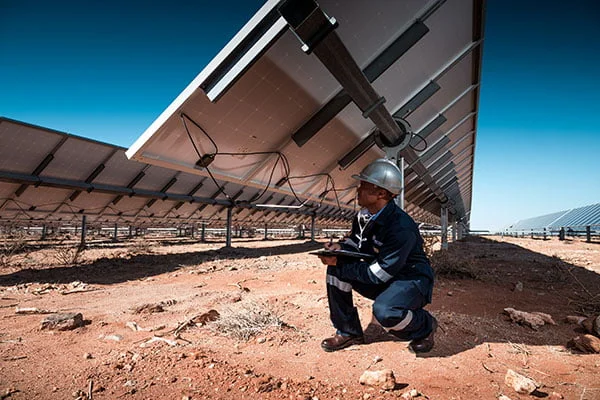Engineers from renewables company Scatec have started work on a massive project in the Northern Cape, which forms part of the South African government’s Risk Mitigation Independent Power Producer Procurement Programme (RMIPPPP).
Once operational the project will have a total solar capacity of 540 MW and battery storage capacity of 225MW/1,140MWh, and provide 150 MW of dispatchable power under a 20-year Power Purchase Agreement. It is due to start supplying power within 15 months of construction starting.
The facility will comprise three collocated projects and will be around 10 kilometres from top to bottom
“We were extremely careful when we started to lay out the facility site. Learning from a rigorous Environmental Impact Assessment process, we realised that there is rich biodiversity in the region, and every precaution was taken to minimise the environmental impact”, explains Jan Fourie, Executive Vice President for Scatec in Sub-Saharan Africa. The company reached financial close on the development of the Kenhardt site, earlier this year.
The mitigation principle they followed, he explains, is “avoidance, then relocation, and only then destruction”. This means that the company would do everything possible to avoid any sensitive local fauna and flora and safeguard local ecosystems.
The Kenhardt region is rich in plant biodiversity. The 16 species of fauna and 99 plants (flora) species of “conservation concern” life puts a special responsibility on anyone who does any kind of construction work in the vicinity.
“If you look at the map and the configuration of our site, you can see clearly how we identified local sensitive areas. Among other ecological sensitivity, we took into consideration the location of quiver trees and hydrology. Even the access roads themselves were carefully planned. We did everything we can to avoid protected plant communities and animal life,” says Fourie.
As part of the development of the site, Scatec had to undertake an Environmental Impact Assessment. This detailed the presence of environmental sensitivities and describes how the company would ensure its protection through a risk mitigation approach.
“We partnered with a specialist team, who partnered and guided us through this process. We had to apply for flora relocation permits and every single relocated plant was tracked and monitored. We made use of the latest Geographic Information System (GIS) technology to record plants species attributes in the field during the search and relocation process. The field data were then fed in real time to an interactive management dashboard with consolidated species information.”
Legislation requires the project to always maintain a net gain of species. In the case of quiver trees, the flora permit requires that 10 new trees be planted for every single relocated tree.
“When you look at pictures of the Kenhardt region you may very well think you are looking at a barren, dry, and desolate landscape. This would be completely wrong, as our research and planning have shown. There is an enormous richness of life in the area, and we will do everything we can to protect it,” says Fourie.
Scatec was, in June 2021, awarded preferred bidder status on three projects by the Department of Mineral Resources and Energy in South Africa – under the technology agnostic Risk Mitigation Power Procurement Programme.
The three projects totalling 540 MW solar, and 225 MW/1,140 MWh battery storage bid based on sites located in the sun-drenched Northern Cape Province of South Africa. The projects have a total estimated Capex of USD 1 billion.















